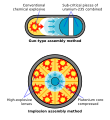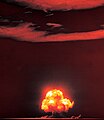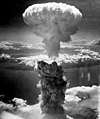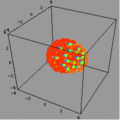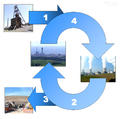Portal:Nuclear technology
The Nuclear Technology Portal
Introduction
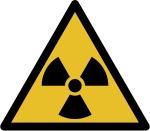
- Nuclear technology is technology that involves the nuclear reactions of atomic nuclei. Among the notable nuclear technologies are nuclear reactors, nuclear medicine and nuclear weapons. It is also used, among other things, in smoke detectors and gun sights. (Full article...)
- Nuclear power is the use of nuclear reactions to produce electricity. Nuclear power can be obtained from nuclear fission, nuclear decay and nuclear fusion reactions. Presently, the vast majority of electricity from nuclear power is produced by nuclear fission of uranium and plutonium in nuclear power plants. Nuclear decay processes are used in niche applications such as radioisotope thermoelectric generators in some space probes such as Voyager 2. Reactors producing controlled fusion power have been operated since 1958, but have yet to generate net power and are not expected to be commercially available in the near future. (Full article...)
- A nuclear weapon is an explosive device that derives its destructive force from nuclear reactions, either fission (fission bomb) or a combination of fission and fusion reactions (thermonuclear bomb), producing a nuclear explosion. Both bomb types release large quantities of energy from relatively small amounts of matter. (Full article...)
General images -
Selected article -
The possibility of nuclear weapons was acknowledged early in the war. At the University of Birmingham, Rudolf Peierls and Otto Robert Frisch co-wrote a memorandum explaining that a small mass of pure uranium-235 could be used to produce a chain reaction in a bomb with the power of thousands of tons of TNT. This led to the formation of the MAUD Committee, which called for an all-out effort to develop nuclear weapons. Wallace Akers, who oversaw the project, chose the deliberately misleading code name "Tube Alloys". His Tube Alloys Directorate was part of the Department of Scientific and Industrial Research.
The Tube Alloys programme in Britain and Canada was the first nuclear weapons project. Due to the high costs for Britain while fighting a war within bombing range of its enemies, Tube Alloys was ultimately subsumed into the Manhattan Project by the Quebec Agreement with the United States. Under the agreement, the two nations would share nuclear weapons technology, and refrain from using it against each other, or against other countries without mutual consent. However, the United States did not provide complete details of the results of the Manhattan Project to the United Kingdom. The Soviet Union gained valuable information through its atomic spies, who had infiltrated both the British and American projects.
The United States terminated co-operation after the war ended, under the Atomic Energy Act of 1946. That prompted the United Kingdom to relaunch its own project, High Explosive Research. Production facilities were established and British scientists continued their work under the auspices of an independent British programme. In 1952, Britain performed a nuclear test under the codename "Operation Hurricane" and became the third nuclear-weapon state. In 1958, in the wake of the Sputnik crisis, and the British demonstration of a two-stage thermonuclear bomb, the United Kingdom and the United States signed the US–UK Mutual Defence Agreement, which resulted in a resumption of Britain's nuclear Special Relationship with the United States. (Full article...)
Selected picture -
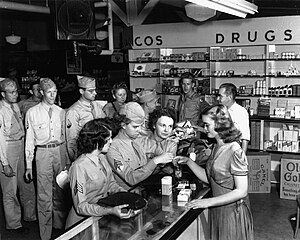
Did you know?
- ... that Project Ketch proposed the detonation of a 24-kiloton nuclear device in Pennsylvania to create a natural-gas storage reservoir?
- ... that plutonium produced in the nuclear reactors at the Hanford Engineer Works was used in the Fat Man bomb used in the atomic bombing of Nagasaki in August 1945?
- ... that after journalist Adele Ferguson's criticism of the U.S. Navy's sex discrimination attracted nationwide attention, she was offered a personal tour of a nuclear submarine?
- ... that before becoming a successful children's author, Myron Levoy was an engineer doing research on nuclear-powered spaceships for a mission to Mars?
- ... that the British Tychon missile was developed from a Barnes Wallis concept to keep strike aircraft safe while dropping nuclear bombs?
- ... that T. K. Jones thought that a nuclear war was survivable if "there are enough shovels to go around"?
Related WikiProjects
Things you can do
| Parts of this portal (those related to section) need to be updated. Please help update this portal to reflect recent events or newly available information. Relevant discussion may be found on the talk page. (September 2021) |
Selected biography -
Franck became the Head of the Physics Division of the Kaiser Wilhelm Gesellschaft for Physical Chemistry. In 1920, Franck became professor ordinarius of experimental physics and Director of the Second Institute for Experimental Physics at the University of Göttingen. While there he worked on quantum physics with Max Born, who was Director of the Institute of Theoretical Physics. His work included the Franck–Hertz experiment, an important confirmation of the Bohr model of the atom. He promoted the careers of women in physics, notably Lise Meitner, Hertha Sponer and Hilde Levi.
After the Nazi Party came to power in Germany in 1933, Franck resigned his post in protest against the dismissal of fellow academics. He assisted Frederick Lindemann in helping dismissed Jewish scientists find work overseas, before he left Germany in November 1933. After a year at the Niels Bohr Institute in Denmark, he moved to the United States, where he worked at Johns Hopkins University in Baltimore and then the University of Chicago. During this period he became interested in photosynthesis.
Franck participated in the Manhattan Project during World War II as Director of the Chemistry Division of the Metallurgical Laboratory. He was also the chairman of the Committee on Political and Social Problems regarding the atomic bomb, which is best known for the compilation of the Franck Report, which recommended that the atomic bombs not be used on the Japanese cities without warning. (Full article...)
Nuclear technology news
- 19 November 2024 – Russian invasion of Ukraine
- Nuclear risk during the Russian invasion of Ukraine, Russia and weapons of mass destruction
- Russian President Vladimir Putin signs a decree that allows Russia to use nuclear weapons in response to conventional attacks by a non-nuclear state supported by a nuclear power. (Reuters)
- 5 November 2024 – Fukushima nuclear accident
- A remote-controlled robot retrieves a piece of melted fuel from the Fukushima Daiichi Nuclear Power Plant, the first time a piece of melted fuel has been retrieved from a nuclear meltdown. (AP)
Related portals
Related topics
Subcategories
Associated Wikimedia
The following Wikimedia Foundation sister projects provide more on this subject:
-
Commons
Free media repository -
Wikibooks
Free textbooks and manuals -
Wikidata
Free knowledge base -
Wikinews
Free-content news -
Wikiquote
Collection of quotations -
Wikisource
Free-content library -
Wikiversity
Free learning tools -
Wiktionary
Dictionary and thesaurus


